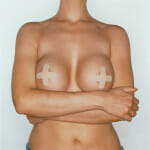The Use of Acellular Dermal Matrix and Biologic Scaffolds in Difficult Cosmetic Breast Surgery Revisions

Over the past 30 years, millions of women have had breast implants for cosmetic augmentation and lifting, as well as reconstruction after breast cancer excision. Difficult problems can arise that sometimes require sophisticated solutions that were not available previously. Breast revision has become a true sub-specialty in plastic surgery. Many patients are referred to Dr. Ereso to treat these difficult problems, as well as treating their own patients that have developed complications.
When a breast augmentation patient develops a complication such as recurring capsular contracture, implant rippling, implant malposition, severe asymmetry or loss of either superior or inferior pole support, Dr. Ereso will perform cosmetic breast surgery revision. In many cases, he can manage the problem with a very innovative solution: the use of a biomaterial called acellular dermal matrix.
What Is Acellular Dermal Matrix?
Acellular dermal matrix (ADM) is a skin graft from which the cells have been removed. Think of it like a lattice or scaffolding of sterile tissue that supports the natural breast tissue. Once placed, the patient’s own cells grow into the framework and in some instances, eventually replace the graft.
ADM has been used for more than a decade, and has yielded many favorable results with a low complication rate. Usually it is used for breast revision operations, although occasionally, ADM may be used in primary breast surgery (if Dr. Ereso feels it would be medically appropriate).
How the Doctors Use These Biomaterials
Dr. Ereso uses Strattice® and AlloDerm® biomaterials (as well as Allergan’s SERI® Surgical Scaffold) to support the natural breast tissue, and improve the appearance of breast implants. They can use ADM to do any of the following:
- Correct the inframammary fold (crease underneath the breast) when an implant has “bottomed out”
- Stabilize the pocket of an implant
- Provide support for the lower portion of the implant in augmentation or implant-based reconstruction cases
- Decrease the appearance of implant wrinkling or rippling
- Camouflage implant visibility in thin patients (particularly reconstruction patients)
ADM is particularly helpful in cases of capsular contracture, when scar tissue forms around the implant, squeezing it and distorting the shape/feel of the breasts. In these cases, Dr. Ereso will place ADM over a portion of the implant to prevent the return of capsular contracture. The intention is that by covering the implant with ADM, the body won’t produce more scar tissue in that location. SERI® surgical scaffold, which is made of silk, is the latest innovation that can be used to treat these problems. SERI® has the unique property of allowing your own tissue to grow into the silk scaffold. After one to two years, your tissue entirely replaces the silk!
Learn More about Acellular Dermal Matrix
For more information about ADM, and how the biomaterial can be used to improve the results of breast implant surgery, please contact Dr. Ereso today by calling (650) 964-6600.


